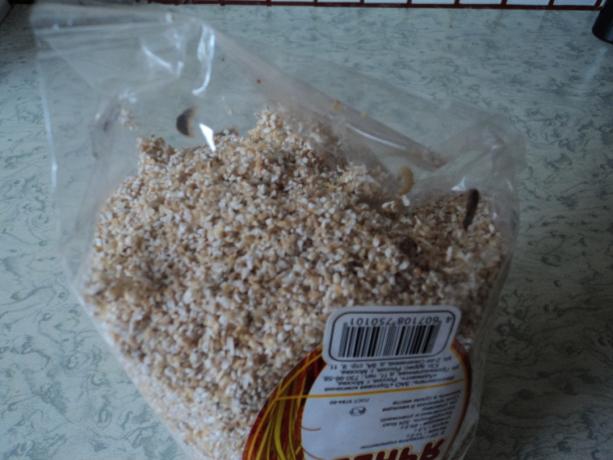Content
-
1 Let's get to know better
- 1.1 Where does food moth come from?
- 1.2 Is food moth and its larvae harmful?
-
2 How to deal with worms in the kitchen
- 2.1 Revision and cleaning
- 2.2 Means of struggle
- 2.3 Prevention means
- 3 Outcome
If you have white worms in your kitchen that for some reason climb on the ceiling, do not rush to accuse yourself or other family members of uncleanliness. These are food moth larvae, and they can appear even in the most sterile conditions.
This small nondescript-looking butterfly less than a centimeter in size flies mostly at night, so you you may not guess for a long time about such an unpleasant neighborhood or decide that you have an ordinary moth. But when caterpillars appear on the ceiling in the kitchen, there is no doubt.

Food moth
Let's get to know better
If you do not look at this insect under a microscope, it is difficult to distinguish it from an ordinary clothing moth. And its larvae are very similar to maggots - fly larvae. White worms with dark heads several millimeters long.
Each mole lives only a few days, maximum - two weeks, but in such a short time it manages to bring out a huge number of larvae, which spoil our lives.
Where does food moth come from?
Since it is a flying insect, it can easily enter your house through a door, window or ventilation duct from neighbors. But much more often we bring its larvae home with our own hands along with food. They can be found in cereals, flour, nuts, dried fruits and even candy.
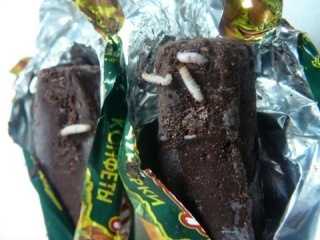
Moth larvae in candy
Poor processing and improper and very long storage are the reason for food moth larvae to become infected. White worms in the kitchen quickly turn into butterflies and begin to multiply, multiplying exponentially.
Read also the article on small bugs in the kitchen.
Is food moth and its larvae harmful?
It is believed that adult moths, both food and common, do without food, they only need water. Whether this is true or not, it is impossible to say for sure, because insects are often found in foods left on the table, especially sweet ones. But even this could have been ignored if the moth had not multiplied so rapidly.
The worms that appeared in the kitchen on the ceiling are a sure sign that the moth has been living with you for a long time and has already managed to cause great harm to your food supplies. She herself may not eat, but her offspring are incredibly gluttonous.
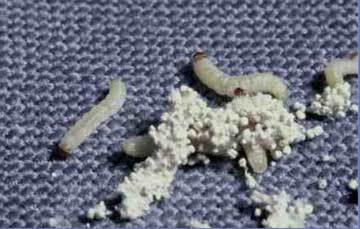
Photo of food moth larvae
Note. The moth settles in any dry food, where it lays eggs, from which the larvae hatch later. They are omnivorous and can even gnaw through plastic bags in which cereals are stored, spreading further and further.
The food itself is not only eaten, but also contaminated with dead caterpillars, their feces and skins remaining after being reborn into an adult. To see such a picture, even filmed on video, is very unpleasant, not to mention making porridge from such cereals, and compote from dried fruits.
Therefore, if white worms appear in the kitchen, you need to get rid of them urgently.
How to deal with worms in the kitchen
There are many methods of dealing with food moths, including folk ones. Each of them may turn out to be more or less effective in each specific case, since these insects have the ability to adapt to the means aimed at destroying them. Therefore, most likely, you will have to try several methods or use them in combination.
But first, you need to conduct an audit in the kitchen and find a malicious "hotbed".
Revision and cleaning
First of all, you need to inspect all products, especially those that are stored at room temperature in kitchen drawers.
- Open every pouch and every can and examine the food carefully. Even if white caterpillars are not visible in the kitchen, lumps of cereal or flour that have stuck together may indicate their presence.
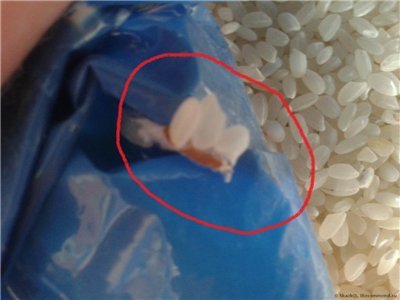
Rice grains glued by a larva
- Do not try to sort or sift the cereal to preserve it - throw everything away immediately with the bag. If contaminated food was stored in a reusable container, it must be thoroughly washed and dried.
- Transfer or pour food that has not been touched by moths into tight-fitting jars.
- Check nuts, legumes and dried fruits especially carefully - the larvae may be sitting inside.
- After the revision, clean up the kitchen by washing not only the dishes and floors, but all the cabinets inside.
Means of struggle
The above instruction is not a panacea for this misfortune. The moth could have laid eggs anywhere, which means that in a few days the worms will reappear in your kitchen.
To prevent this from happening, use the following tips.
- Immediately after cleaning and washing all surfaces with soapy water, ventilate the kitchen well, and then generously lubricate all inaccessible places with vinegar: cracks, seams between the countertop and the apron. You can even put vinegar in a spray bottle and spray it if you can't reach tight spots. Close all windows, doors and vents tightly for an hour and a half. And ventilate again.
- Place the peeled garlic in the cabinets. It can even be put in containers with cereals.
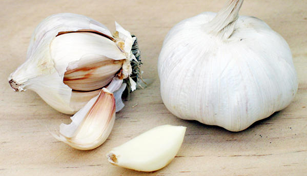
Moles don't like the smell of garlic
- The pungent smell of mint, lavender or wormwood can also scare off moths. Bunches of these fresh or dried herbs can also be stored in tightly closed cabinets.
For reference. All these folk methods are based on the fact that moths do not like pungent odors. Therefore, as such a repeller, you can try using spices (cloves, peppers, bay leaves) and house plants, for example, geranium.
Unfortunately, the described methods do not always work: instead of dying, the larvae can happily eat garlic or pepper. In this case, there is no choice but to get rid of worms in the kitchen using chemistry.
Modern chemicals include:
- Special traps for food moths. Designed for adult insects that fly into the trap, attracted by the smell. They will not help get rid of the larvae, but the adult moth will die and will not reproduce further.
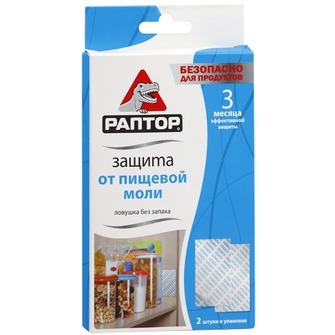
Trap Raptor
- Insecticides. The most reliable remedy, but it must be used strictly according to the instructions so as not to harm yourself. The price of such drugs is low, so buy several different products - insects may be adapted to some of them.
Read also the article on bugs in the kitchen.
Prevention means
Once you get rid of the food moth, you cannot be sure that it will not reappear.
Therefore, it is necessary to take preventive measures:
- All products brought home should be immediately transferred to a hermetically sealed container, while checking them for larvae.

Proper storage of cereals
- Store cereals and other bulk products covered. Even if worms appear in them, they will not be able to damage other foods.
- Do not make large, long-term stocks.
- More often direct inspection and cleaning in cabinets, lay out herbs or spices with a pungent smell in them.
Outcome
No matter how clean and tidy your kitchen is, there is no guarantee that insects, including moths, will not appear in it. But if you follow preventive measures and respond to their appearance in time, they will not be able to poison your life.
Midges in the kitchen - see here.

